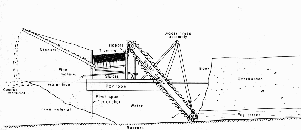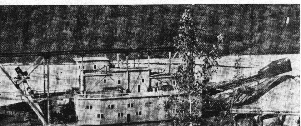Mining in Manitoba |
Dredging |
||
Surface Mining Methods
|
Large alluvial deposits are mined by floating washing plants capable of excavating the gravel, processing it in the washing plant, and stacking the tailings away from the dredge pond. Two kinds of equipment-bucket line and dragline--have been used. The bucket line dredges are larger and more efficient, consisting of a continuous line of buckets that scoop the material from the gravel bank at the edge of the dredge pond, raising it to the top of the washing plant mounted in the hull. Dragline dredges are smaller and less efficient, and employ a single bucket that digs the gravel and is swung over the feeder hopper of a floating washing plant similar to the layout in a bucket line dredge, although usually smaller.
Dredging temporarily involves total disturbance of the ground surface, although with careful planning and engineering of the operation it is possible to plan for restoration of the surface, and perhaps even to improve some aspects of the flood plain or nearby river channel. It is not possible to restore the land to the precise original contour, for the swell factor of the gravel increases volume 20 percent or more. In many areas in the West, particularly near major construction projects or cities, clean gravel placer tailings are valuable for manufacture of aggregate, or crusher run, in fills of various kinds, and can be considered a resource in their own right. In a few areas, people traveling through areas of old placer tailings, expecting the area to be some sort of wasteland, are pleased to find a great variety of fishing and water sport recreation available, and thriving wildlife in the habitat that has been created. Because large placer deposits can be thoroughly explored before floating the dredge, such operations lend themselves to thorough planning, and it is possible to do a considerable amount of reclamation at only slight increase in overall operating costs.
|


